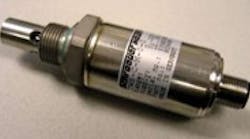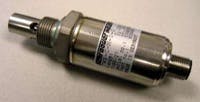The two biggest enemies of hydraulic fluid are water and high temperature. Water not only prevents hydraulic fluid from lubricating components, but it can alter chemical additive mixtures in a fluid, rendering them less effective and dramatically shortening fluid life. Excessive heat causes oxidation of the oil — again, rendering it less effective and shortening its life.
A new tool in the battle against water and heat is the Testmate Water Sensor (TWS-C), which continuously monitors water content and temperature of hydraulic and lubricating oils. Introduced by Schroeder Industries, Leetsdale, Pa., the TWS-C measures water content relative to the percent saturation of the fluid. Measurements range from zero (indicating no water) to 100 (indicating 100% water).
The TWS-C can be directly installed into a hydraulic system via its threaded connection. Schroeder recommends the sensor be mounted vertically in a known turbulent area with the mechanical connection pointing upwards. In addition, the sensor should be fully submerged, with fluid flowing freely around the sensor.
For additional information, call (724) 318-1100 or visit www.schroederindustries.com


